| Rome | Venice | Bologna | Florence | Padua/Verona/Vicenza |
Rome
There are many conferences held in Italy during the summer. Even though those meetings are held in other cities of Italy, you are tempted to spend time in Rome, because of the city's historical significance. Let us see some photos from Rome.
Termini and Its Vicinity
- Two thousand years ago, all roads led to Rome. These days, all roads lead to
the Roma Termini. The Termini is a great city! Let us look at some photos.
- Termini. Southern Entrance to the Termini Building.
- West-side Annex to the Termini for shops and restaurants.
- Public Telephones. Italians still seem to be using public telephones. There are of course many foreign visitors whose cell phones do not work in Italy.
- Green Power Advocates. How do I look as one of them?
- Ticket Windows, as most neglected places.
- Fast Food Place. There are many places for fast food. This is one of the Roman-style places.
- Macdonald's. American institution.
- Complicated Geography. You can get lost very easily.
- Roman Ruins in the basement.
- One of the Gift Shops. with artistic decorations.
- Italian Trains with artistic decorations.
- Hotel District on the west side of the Termini.

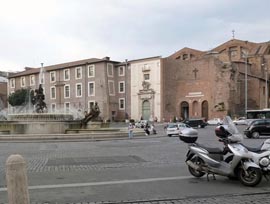
- Piazza della Repubblica is one block west of the Termini.
Like all Roman plazas, this area is centered around a fountain, and
surrounded by buildings of historical significance.
- On the west side of the fountain, there are two circularly curved buildings. The narrow separation leads to via Nazionale leading to the monument of Victor Emanuel II. Those buildings thus could have been used for government offices in the past. These days, they are mostly for luxury hotels, like this.
- On the east side, the buildings are somewhat humble looking. There used to the Great Roman Bath House accommodating 5,0000 people. Some of the walls are still standing, and facing the plaza.
- Some pizza cafes are on the ground floor of one of the curved buildings.
- MacDonald's has its own class throughout Europe.
- Graphic artists are also in the Plaza area.
- On the east side of the Plaza, there is a church built into the Roman bath house.
- Basilica Santa Maria degeli Angeli e dei Martiri is built into the Roman
bath house on the eastern ring of the Piazza Repubblica. This church has
its history.
This bath house, constructed by Emperor Caracalla (211-2173), was capable of accommodating 5,000 people simultaneously. It was a great gathering place for those Roman citizens. Perhaps, it was like a resort beach.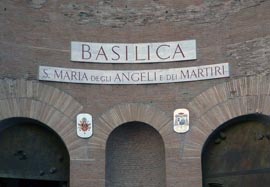
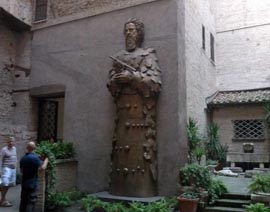

- Entrance to the Basilica carved into the Roman wall (from the ruins of the Roman bath house).
- Inside the Basilica (from the public domain).
- Main altar of the Basilica.
- One of the side altars.
- Another side altar.
- Church organ next to an elegant painting.
- Modern sculpture surrounded by Roman walls.
- Model of Galileo's pendulum inside the Basilica.
- Statue of Galileo in the backyard.
This statue was designed by Tsung-Dao Lee of Columbia University. He
shared the 1957 Nobel prize in physics with C. N. Yang.
Click here for more about T. D. Lee.
- It was an honor for me to have photo with T. D. Lee's Galileo in Rome.
- In 1623, Galileo was found guilty
for his theory not consistent with the church doctrine. He is now called a
"Divine Man" in this church.
The Galileo story has been inspirational to me from my childhood. I received two death sentences (ordering me not to do physics) in the past. I received my first death sentence in 1966 for publishing a paper not consistent with the physics establishments at that time. Click here for a detailed story.
I received my second death sentence in 1983. I am not ready to tell the full story yet, but I may in the future. The point is that those who punished me are now gone from the physics. - The construction of this Galileo statue was apparently financed by the Chinese Academy of Sciences.


- Roman National Museum is near the north-west corner of the
Termini. This museum is built on the site of the Roman bath place for
upper-class Romans. There are of course many things to see inside, but
photo-taking is not allowed. There are also many things to see on
the out-side ground.
- Entrance the Museum Building.
- Roman Garden with Roman pillars.
- One of the Walls of the Roman Bath House.
- Some of the Statues. Only ruined statues are outside. All good statues are inside. You have to pay an admission fee to see them.
- Roman Tomb Stones.
- Esso Gas Station near the Museum. There used to be many Esso gas stations in the United States, but they all became Exxon stations in 1965. The Esso sign is a great museum piece for the visitors from America.
- Italian Trash Cans are stylish and artistic to those from the United States. They are also museum pieces.
- The point is that the entire city of Rome is a great museum. Rome is a great history class.


-
Teatro dell'Opera di Roma is also within a walking distance from the Termini.
- Front view of the Theatre. The appearance of this box-like house is somewhat disappointing. This building does not reflect the fact that Italians invented both opera and architecture.
- Another View of the Theatre.
- The main lobby before the performance.
- Pietro Mascani's plaque was on the wall of the main lobby.
- Prokofiev's Romeo was on the program. I did not buy the ticket, because I saw this ballet twice before in Russia. Once in Kazan (1999) and once at the Mariinsky Theatre in Saint Petersburg (2010).
- Members of the Opera orchestra were having a relaxing moment before the performance, and I was talking to them. I told them I saw the same ballet at St. Petersburg's Mariinsky theatre in 2010. They told me not to brag too much. They were going to St. Petersburg after their performance in Rome. It is always a pleasure for me to talk to musicians.

|
| |

|
Sapienza University of Rome
- Entrance to the Campus.
- Campus seen from the entrance.
- Treed Archway near the Physics
Building.
- Physics Building, called Institito Fisico Guglielmo Marconi. I like Marconi. How much? Click here.
- Entrance to the Physics Building.
- Foreground of the Physics Building seen from the second floor of the Building.
- Another scene from the second floor. The big building is for the school of Italian literature.
- with Physics Graduate Students in front of the Physics Building. I like students. This is my job.
- My real job is learning new things. I met this architecture professor near the campus, and had a brief conversation with her. I learned some important things from her. I have been and still am interested in Italian architecture.
- Marconi's Bust. I like Marconi. How much?.
- Enrico Fermi in Fermi window in the main lobby of the Physics Building.
- Fermi, Heisenberg, and Pauli
also in the Fermi window.
- Scientific Instruments invented or developed in this institute.
- Galileo and Milton. You can recognize their faces in this photo. We all know why Galilee Galilee is an important person to Rome. He received his death sentence there. John Milton was an English poet. Why is here?

|
| |

|

|
Colosseum and its Vicinity
-
Emperor Vespasian (69-79) started constructing this Colosseum using the
sentences taken from Israel after crushing the Masada revolt. His son,
Emperor Titus (79-83 AD), completed the construction.
- Colosseum,
Rome's No. 1 address, seen from Via dei Imperiali (photo taken in 1994).
- Close-up View.
- Colosseum Walls in detail. The ground floor is with Doric-style columns, the second floor with Ionic columns, and the this floor with Corinthian columns. Romans rigorously reproduced Greek art. Even these days, these three types of columns dominate throughout the world.
- Underground walkways for lions and gladiators.
- The remaining sitting steps. Most of those steps collapsed.
- This poster illustrates how those Roman citizens spent their time on those steps.
- The steel cross
mark the place for the Emperor's elevated box. The cross was set up by Pope
John-Paul II.
- Constantine Arch south of the Colosseum.
- Constantine Arch and Colosseum seen together.
- Constantine Arch seen from the second floor of the Colosseum.




- Palatino is the palace near the Colosseum. Many (not all) Roman Emperors
had their private houses in this palace compound.
- Pine trees along the Roman road in the palatino compound.
- Roman pavement.
- Botanic garden.
- Imperial sign engraved into the Roman wall.
- Another imperial sign.
- Meeting place. This could have
been a place for meetings and ceremonies.
- House of Augustus, the first
Roman Emperor. I am standing at its entrance.
- Map of his house. Compared with his historical weight, his house was quite modest. During his time, the emperor's power was not completely established.
- The wall of one of his living rooms.
- Another living room.
- Horse stable, it appears like.
- Places for servants, they appear like.
- Service area. This place could have been the kitchen.
- The city of Rome seen from the Palatine's high ground.
- The dome of St. Peter's Basilica.
- Temple of Mauritius. Menelaus was the last non-Christian emperor (306-312).
- The Colosseum seen from the Palatino's high ground.
- Roman Forum consists of the remains of the ancient Roman government. During
the course of history, the ground went down, but the stones are still there.



- The Arch of Titus (east gate) seen from the Roman Forum. Seen from Colosseum side.
- The Roman Forum seen from the Palatino's
high ground.
- These columns are still in good shape.
- Julius Caesar was killed in front of these three columns.
- Remains of the government buildings.
- One of the government buildings still standing.
- These columns are still in good shape.
- Temple of Maxentius. The construction
of this temple was started by Emperor Maxentius, but was completed by Constantine
who overthrew him after the battle at the
Ponte Milvio in 312.
- The Arch of Septmus Severus, west gate to the Forum. It is still in good shape, presumably refurbished many times. Seen from the Forum ground.
- Pines of Rome along the
boulevard leading to the Constantine Arch from the Chariot Race Way.
- Circo Massimo was used for Roman chariot races.
- Roman buildings along the raceway.

- Monument to Vittorio Emanuel II and its Vicinity.
In 1870, Italy became totally unified with Rome as the capital city. This
impressive structure was constructed to commemorate this happy event.
- Victor Emauel II Monument. also known as the Altar of the Fatherland.
- Another View of Monument.
- Tomb of Unknown Soldiers. More than 600,000 Italian young men died during World War I.
- from the top of the Castel del Sant'Angelo, near the Vatican City.


- Where is Julius Caeser? There are many statues in Rome to honor this man.
This is
one of them. I spotted this statue in 1994 on
a street near the Colosseum, but I am not able to give the exact location.
- The statue of Marcus Aurelius is behind this Monument.
- Marcus Aurelius with a newly wed couple.
- Marcus Aurelius with his
descendants. While I was admiring Marcus, four Italian gentlemen came to
me, and one of them claimed he was a descendant of Marcus. I congratulated
him. The second man claimed his ancestor was Julius Caesar, and the third
man said he is a descendant of Constantine the Great. The fourth man remained
silent. I asked him whether his ancestor was Nero. He said Yes.
They then claimed Italians are the only ones who know how to run the world. Caesar ran the world using his army, and Medici figure out how to run with money. Berlusconi (their prime minister) is trying to run the world with communication (they said in 2009). I asked them whether he is going to succeed. They said they do not know.I then told them Italians did not invent democracy. They said they never heard of democracy. It is always fun to talk with Italians.

|
| |
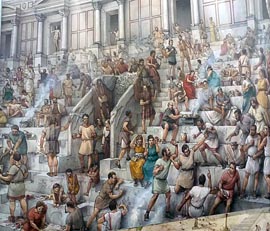
|
Must-Visit Places and Interesting People in Rome
- Spanish Steps, with 138 steps, connect the Spanish Embassy at the top
and Piazza di Spagna at the bottom. There are always young people ready
to talk to you and have photos with you. Let us look at some photos.
- History of the Steps. Spain used to be a dominant country to Italy. These Steps thus tell a very interesting story.
- Interesting People from all over the world.
- Photo from Wikipedia. The Steps with a large crowd.
- Sunset Scene of the Steps.
- Friendly Romans at the top of the Steps.
- God created me first, and then two Italian women.
- with high-school students
from Germany (2000).
- Bottom of the Steps with many interesting people.
- On a rainy day, they are still there.
- This art student from England wanted have
a photo with me in this way. She wanted to pose as an Italian statue.
- Piazza di Spagna (Spanish Plaza) extending the bottom of the Steps.
- Fontana della Barraccia (boat-shaped fountain)
at the plaza.
- Spanish Embassy at the Plaza.
- Stature of Queen Isabella in front of the Embassy.
- Italian army jeep guarding the Embassy.
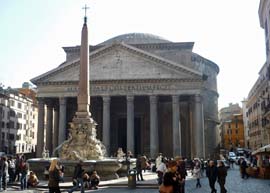
Greek and Roman technologies 
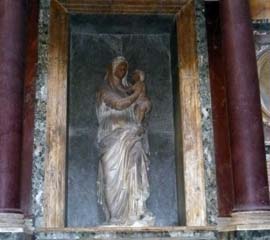
- The Roman Pantheon was built by Emperor Hadrian in 126 AD. Its purpose was to
entertain
all gods known to Romans. Its architecture combines the Roman dome and Greek columns.
This tradition continued until 1943 when the Jefferson memorial was built in
Washington, DC, U.S.A., and will continue. Let us look at some photos of this
historic construction.
- Entrance and the Obelisk. The Obelisk came from the Egyptian tradition. The entrance style came from Greece. What is inside?
- A huge ceiling without supporting poles. Romans developed this technology. The opening at the top was for bringing in sun light from the sky. Romans did not have electric lights.
- Each block on this ceiling is to
represent one of the numerous Roman gods.
- The heavy Roman roof is supported by thick Roman walls. Is it possible to replace those walls by Greek columns?
- Thomas Jefferson Memorial in Washington,
DC, U.S.A, inherits this spirit of combining Greek and Roman inventions.
Thomas Jefferson was quite fond of this Italian tradition, and built
his own house according
to the idea originated by Emperor Hadrian.
- Inside, the Pantheon is a Christian
museum. The museum items include
- this early church organ,
- a portrait of the lady holding her baby above the romb of Rafael.
- Christmas set up was still there during the first week of January (2009).
- Tourists are always there. I had a photo with Japanese students who came to Italy during their winter break.
- Click here for more photos of the Pantheon.


- Castel Sant'Angelo was built for Emperor Hadrian's mausoleum, but it served
many different purposes depending on the political climates of Rome. This
castle is located on the northern bank of the Tiber River. It is about 2km
east of St. Peter's Basilica.
- The castle and the Tiber Bridge seen from another bridge south of the Castle.
- A close-up view of the castle, seen from the southern bank of the Tiber River.
- Angel at the top. The Italian word "angelo" means "angel" in English. The Castle is thus called "Castle of Angel."
- Pope's secret walkway connecting
this Castle with the Pope's residence in Vatican.
- Porous Bottle in this Castle. There were no refrigerators until the 20th century. Water was cooled by porous bottles. When a small amount of water comes out through the porous wall, it evaporates quickly and takes away heat. This technology was developed in ancient Egypt and used by Greeks, Romans.
- St. Peter's Basilica seen from this Castle.
- The monument of Vitttorio Emanuel II seen from this Castle.



- Italians believe in fountains, and there are many in Rome.
- Fontana Trevi is the most
prominent fountain in Rome. I have been there many times and I met
many interesting people.
- Many people admiring the Fontana.
- I was there in January of 1998.
- St. Peter's Square will not be complete with a fountain. The Obelisk in the background id a different structure.
- Another Fountain not far from the Vatican City. Please let me know the name of this fountain.
- Fontana della Barraccia (boat-shaped fountain) at the bottom of the Spanish Steps.
- Wall-mounted Fountain at the Vatican Museum. There are many wall-mounted fountains in Rome, because they are easy to build. They do not require the lands.
- Fountain and Obelisk in front of the Pantheon.
- Piazza Navona is near the Pantheon. There are
three fountains in this plaza.
- This fountain is with an obelisk.
- This fountain is without an obelisk.
- Minor characters in the fountain are major art products.
- Humans look better than stone statues. I am with three ladies from Belgium.
- There are many other fountains in Rome This is a Wikipedia page dedicated to this subject. This page does not contain all the photos given above. Indeed, it is not possible to list all the fountains in Rome.
- Fontana Trevi is the most
prominent fountain in Rome. I have been there many times and I met
many interesting people.

|
| |

|
| |

|
Vatican City
- St. Peter's Plaza. Many people come to this plaza to listen to the Pope
every Sunday.
- Every Sunday, people come to
the Plaza to listen to the Pope.
- From this window, the Pope speaks.
- They not only listen, but make their own cases known to the crowd.
- The Plaza during the evening hours.
- Polish nuns from Krakow. They were mighty proud of their hometown man, Pope John-Paul II. This photo was taken in 1998.
- Another set of proud people. The Pope's residence is guarded by two Swiss soldiers. They were mighty proud of their job. When I wanted to take a photo, they told me to move away before doing anything. I am still wondering whether they carry pistols and know how to use them.
- Christmas at the Plaza.
- Rock Concert during the Christmas season.
- From this window, the Pope speaks.

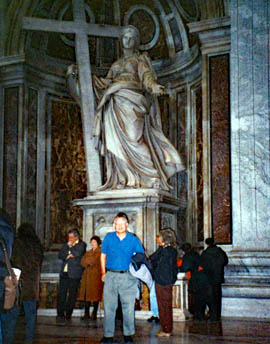
- Every Sunday, people come to
the Plaza to listen to the Pope.
- St. Peter's Basilica. This building serves as the headquarters for
all the Catholic churches in the world.
It has a long and complicated history. You may go to the
Wikipedia page to learn about this building.
- The Basilica with its Obelisk seen
from St. Peter's Plaza.
- The Basilica seen at the sunset hour.
- The place of Worship. It serves as a place of worship and religious ceremonies.
- The Altar. A detailed view.
- Another Altar. There are many, and I did not count.
- The Basilica is also a great Museum, with its unique interior, and many art items.
- Shrine of Saint Helena. This art work appears often on TV and is well known to us all. Who was St. Helena ?
- Marble Sheet. The sheet in this photo is made of marble stones.
- Michelangelo's Pieta is in this Basilica. I took a photo, but its quality is not satisfactory. You are invited to Wikipedia's Pieta for a professional-quality photo.
- The Basilica seen at the sunset hour.

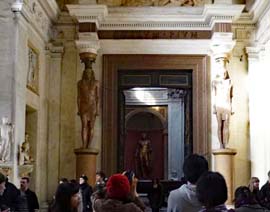
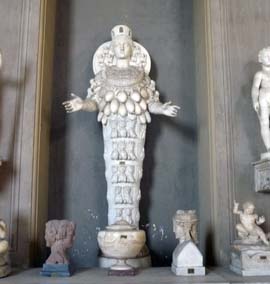
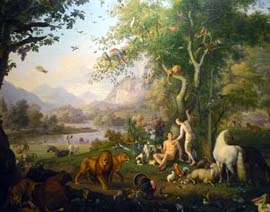
- The Basilica with its Obelisk seen
from St. Peter's Plaza.
- Vatican Museum contains many valuable historical items, covering Egyptian, Greek and
Roman civilizations. Its core is the Sistine Chapel consisting of Michelangelo's
masterpieces. You have to make at least one pilgrimage to this holy place if
you wish to be regarded as a civilized person.
- Entrance to the Vatican Museum.
Vatican is a walled city, and its entrance is one of the wall entrances.
This museum is not open everyday. You have to check the Museum schedule before
going there.
- Egyptian Human Pillars. From this, it becomes quite clear that Greek human pillars can be traced back to the Egyptian civilization. Many people are taking photos. I used to think Greeks invented this form of art. Click here.
- There are many Egyptian items
arranged to teach us lessons.
- Artemis was the Greek goddess of fertility. Apostle Paul got into trouble for saying a man-made idol is not a real god in the Greek city of Ephesus now in Turkey.
- Bust of Emperor Hadrian. Hadrian ruled the Roman Empire from 117 to 138 AD. He was a talented man. He was a gifted architect and built Rome's pantheon. He was also a brilliant military man. He consolidated the boundary of the Empire.
- Garden of Eden. This painting
catches your eyes. God created a woman by pulling out one rib from a
man's body. My grandmother told me I have one less rib on my left chest.
When I counted the ribs from my X-ray photo, I have the same number on
each side. Thus, I had to create my own theory of the Garden of Eden.
Click here if you are
interested.
- This Museum is high-rise building and employes modern technology. It has escalators as well as spiral stairways.
- It has an open space for fresh air.
The dome of St. Peter's Basilica
is seen. From this you can figure out how high this place is.
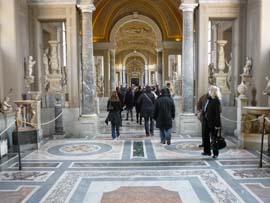
- Entrance to the Sistine Chapel. There some distance between the entrance to this Chapel and the entrance to the Museum. You have to walk, and you will get tired when you reach the Chapel.
- Sistine Chapel. You are not allowed to take photos in this chapel, but many people do. I also have took many photos there for my own collection. However, it would not be nice to post them to this webpage. Instead, I am asking you to go to this Wikipedia page for a comprehensive coverage of this important place.
- Entrance to the Vatican Museum.
Vatican is a walled city, and its entrance is one of the wall entrances.
This museum is not open everyday. You have to check the Museum schedule before
going there.

|
| |

|
Constantine and Ponte Milvio
-
Ponte Milvio. is a bridge across the
Tiber River 30 kilometers
north of the Vatican City. I went there in October of 2010 to take
some photos. Why did I go there?
I have a strong Christian background, and I try to identify myself with a Bible character whenever I am in trouble. For instance, I identify myself with Nicodemus when I had an audience with P. A. M Dirac. In so doing, I developed my way of believing in Jesus: translate miracles in the Bible into what happened in the real world. I believe in Jesus in the way I do physics.
- In modern democracy, the government should be totally separated
from religion. However, it is not a simple matter. Indeed, Emperor
Constantine proclaimed the Edict of Milan in 313 AD, and Christianity
became the state religion of the Roman Empire. Many people regard
this as the most important Christian event only next to the birth
of Jesus in 4 or 0 BC and Apostle Paul's journeys.
Church ministers usually say that the Edict of Milan was a miracle created by God, but one of my clergy friends told me Constantine ascended to his throne with the political support from Christians. This made sense to me, because becoming the head of state is a political issue. Then I assumed that Constantine became the Emperor through a peaceful process, because I still believe Christianity is a religion for peace.
In June of 2010, Professor Luigi Accardi told me there was a bloody battle between Constantine's Christian group and his rival faction headed by Maxentius at a bridge across the Tiber River north of Rome. He said his house is two blocks away from the bridge. Four months later in October, I went there to take photos. Let us see some of those photos.


- The Bridge viewed from
the south. The original bridge was built 500 years before
Constantine, and it was rebuilt several times even after Constantine.
The Tiber River remained the same.
- Another view of the Ponte Milvio. The structure appears to be about 200 years old. There should be the exact date of this reconstruction, but I do not have enough information.
- The Bridge with its entrance tower.
- The Bridge hidden by leaves.
- The Bridge Tower at the western entrance.
- East-side Entrance Tower and
the surface of the Bridge seen from the west.
- Modern Bridge north of the Ponte Milvio. This photo was taken from the Ponte Milvio. The photo shows a perfect reflection. The Tiber River is beautiful!
- One of the Sculptures next to the Bridge tower.
- Locks left by tourists. Some tourists leave locks with their names on the Bridge. Their idea is that their names will stay there as long as the Bridge stays alive.
- Resting Place at the entrance to the Bridge.
- Perhaps you knew all these, and I am telling you nothing new. However,
you will still like my way of learning. Go there and look at the real
thing. I follow the ethics of physics.

- My photo with Luigi Accardi.
Prof. Accardi lives two blocks away from the Bridge in a quiet residential
suburb of Rome. This photo was taken while we both were attending a
conference held in Minsk (2002).
- The Milvio Town Center on the west bank of the River.
- Up-scale Condo Buildings. The town of Milvio is a residential suburb of Rome.
- Photo with Italian Students. The town of Milvio has a number of trendy cafes. While I was having a lunch at one of them, I met these Italian students enjoying their Saturday afternoon. Wherever I go, I talk with students and have photos. These students seem to enjoy cigarettes.

|
| Constantine (above) and Maxentius from Wikipedia. |

|
- copyright@2012 by Y. S. Kim, unless otherwise specified.
- Click here for his home page.
